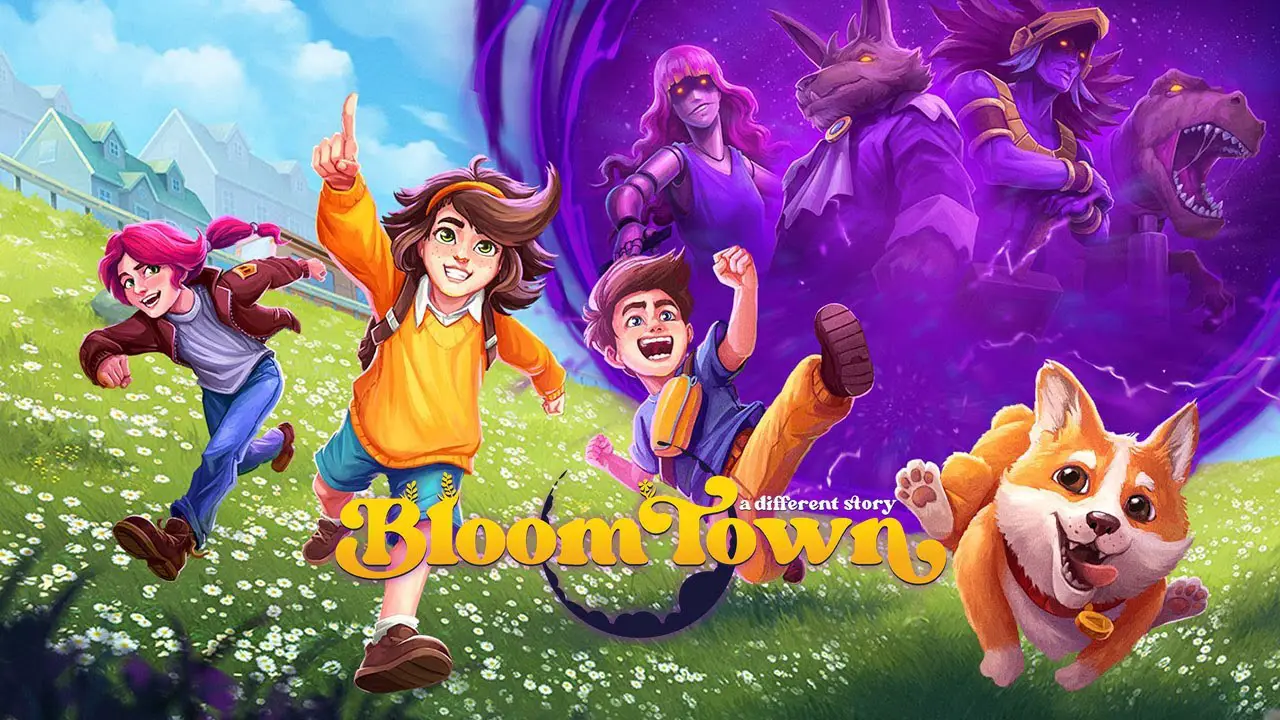Imagine if you threw Persona, a bit of Stranger Things, a dash of Stardew Valley, and a pinch of Pokemon into a pot. I am not sure what this creation would look like, but I am pretty sure it would look a lot like Bloomtown: A Different Story, a turn-based RPG clearly inspired by Persona, Stranger Things, and others.
Story
When Emily and Chester’s parents get a divorce, their mother sends them off to live with her father (their grandfather) in Bloomtown for some time while she sorts things out at home and focuses on her job. For Emily and Chester, this will be their first time in Bloomtown, and from my understanding, it has been some time since they last saw him.
When the two siblings arrive at Bloomtown, they are met by a young man who is not their grandpa but has agreed to take them to their grandpa’s house, which isn’t too far. After a short walk and conversation with the stranger, the pair finally arrive at their grandpa’s, who quickly gives them a rundown and something about needing to work if they want stuff (the stuff all old people say). Because they arrived so late, their grandpa tells them it is almost time for bed, and because of a child who has gone missing, no children are allowed to leave after ten.
Due to traveling for so long, Emily does a quick cleanup of her new bedroom and goes to bed. Something I didn’t mention on purpose is that while on the bus with her brother, Emily has a choice to mention the strange dreams she has been having that include demons/monsters. Tonight is no different, but this time, her dream seems more real than other times, and she is greeted by none other than the man downstairs, Satan.

At this point, the assumption is that Emily is currently in hell, but it may not be, as it looks nicer than our perception of what the hell should look like. Emily’s new friend, Satan, talks about three demons he needs us to capture, and in return, he offers up some of his power so that Emily can complete the job. We can reject the power at first, but it won’t be too long until Emily takes that power to save the world (at minimum, Bloomtown).
Gameplay
Bloomtown’s gameplay is a combination of Persona and Stardew to a degree. Style and the beginning of the game is very Stardew with the main character travelling via a bus to a place her grandad lives. I know in Stardew you are given a farm from your dead grandad, but your alive grandad does tell you that you can use the backyard to farm in here, then there is also fishing and the days with times that give off Stardew Valley vibes, but that’s where it ends, and thankfully this aspect, except for the days progressing, is minor and can be skipped.
I will be honest: when I first started the game and I was getting those Stardew Valley vibes, I was a tad worried because I am not big on farming games or farming aspects in a game luckily that stuff doesn’t seem to be a big deal and after learning them can be forgotten about. It is there if you want to do it, and if not you can leave.
That takes us to the main style of the game, which at its core is a turn-based RPG inspired by Persona or, in fact, any type of media that has a character going from one world (real world) to another world (fantasy world). Of course, the main inspiration is Persona because Satan and his room act a lot like the Velvet room seen in the Persona series.
Like the Velvet Room, Satan’s room is a hub room where the player can do all sorts of things, like level up their favorite demons by absorbing another demon. Which in itself is like fusing, but you keep that same demon, except it gets stronger and may have a chance to learn a new power. This isn’t where the Persona similarities end. Like Persona, each character has their own main demon who is with them forever, but unlike Persona all the characters can have another demon attached to them adding new abilities when in battles.

The lesser demons can be caught on the battlefield which can only be done when all enemies have been downed, another aspect from the Persona series which I will cover in the battle section of the review. There is also inspiration from The Matrix like having to answer a phone in certain spots to get out of the fantasy world and to go back to the real world. As a fan of alternate worlds, I loved this aspect and loved seeing the inspiration and how the developers adapted it for their game.
Demon World/Bloomtown
As you may well be aware by now, Bloomtown is divided into two parts. Bloomtown, which is where the player can do normal day-to-day things like going to the library to find a demon book, doing chores for grandpa, shopping, fishing, garden; all the normal things a teenager would do. Then there is the Demon world, which is where all the fun stuff happens, like fighting demons, listening to by far the damn best battle music I have heard, and capturing demons if you are lucky.
Oh, and did I mention fighting demons with awesome battle music? I know I already mentioned that, but I feel like I needed to say it twice because the music when entering battles is so catchy that I sometimes let my battles drag out longer than they should have.

There is also a big difference between the color palettes of both worlds. The main (real world) has lighter colors, making that world seem safe and peaceful, with the demon world containing darker colors, giving off more of a grim tone. The music also adds to each world’s ambiance.
The real world, for example, has softer music that gives off a relaxing vibe when in town, and in the Demon world, it is the reverse with a tenser vibe. For some, this may not matter so much, but for me, I loved how the developers tried to separate the worlds and make them feel different.
Combat
It is finally time to discuss the nitty gritty of Bloomtown and that is the combat. As I have mentioned before, Bloomtown is a turn-based RPG and the combat resembles Persona in more ways than one. The turn-based battles function similarly to old-school games in that one side takes a turn and then the other side over the more modern way where a whole host of things determines a character’s turn.
I am going to be honest here: I prefer the old-school way because, in my opinion, it is clear, and I know when it is my turn, all my characters are going to have a turn unless they are affected by something. Each character has multiple commands at their disposal. There is a standard attack, which I don’t need to explain, and then there is the ranged attack, which functions a lot like the guns in Persona 5, where the character has a limited amount of ammo during each battle that gets reloaded after the battle ends.
For example, Chester is the only character to start with a gun that has six bullets per battle, and after those six bullets are used up, he can’t shoot any more until the next battle. Finally, there are the demon abilities that differ between each member, depending on their main demon and their side demon.

Speaking of demon abilities, they are much more interesting than you think. Depending on the ability, some of them can be stacked, for example, if Emily burns an enemy, another character can follow that burn up with a water attack which will increase the damage from the water attack. The downside to this is it dispels the burn, meaning the enemy won’t have a burn status effect anymore.
The game hints at multiple ways to stack abilities when selecting an ability. Your characters start off with an ability or two, but as they level up, your main demon will learn new abilities. This isn’t the only way to learn new abilities, as each character can have an extra demon, a captured enemy, to be precise.
How do you capture enemies, you ask? First, you have to down all the enemies and how you do that is a lot like Persona, using an enemy’s weakness against them will knock them down. When all enemies are down, that’s when you can try to capture one of them. But if you already have all the demons, you have downed, or you don’t want them, or they are too strong, you do have another option, and that is to make an all-out attack that has all your characters to a reasonably powerful attack on all enemies, like in the Persona games. I know something else from Persona, but that’s not a bad thing. In fact, it is a good thing, and it shows the developer’s love for Persona games with their own spin.
Conclusion
In the end, Bloomtown: A Different Story is a massive love letter to the Persona Franchise. Almost every little detail that Persona inspires is lovingly crafted to replicate the series yet be different enough that it doesn’t look like a copycat. I loved everything about it, and if you are a fan of the Persona series it is one homage that must be played. Plus, it has some of the best battle music I have heard in a while at least I loved it that I debited buying the soundtrack, on second thought I may just do that.







